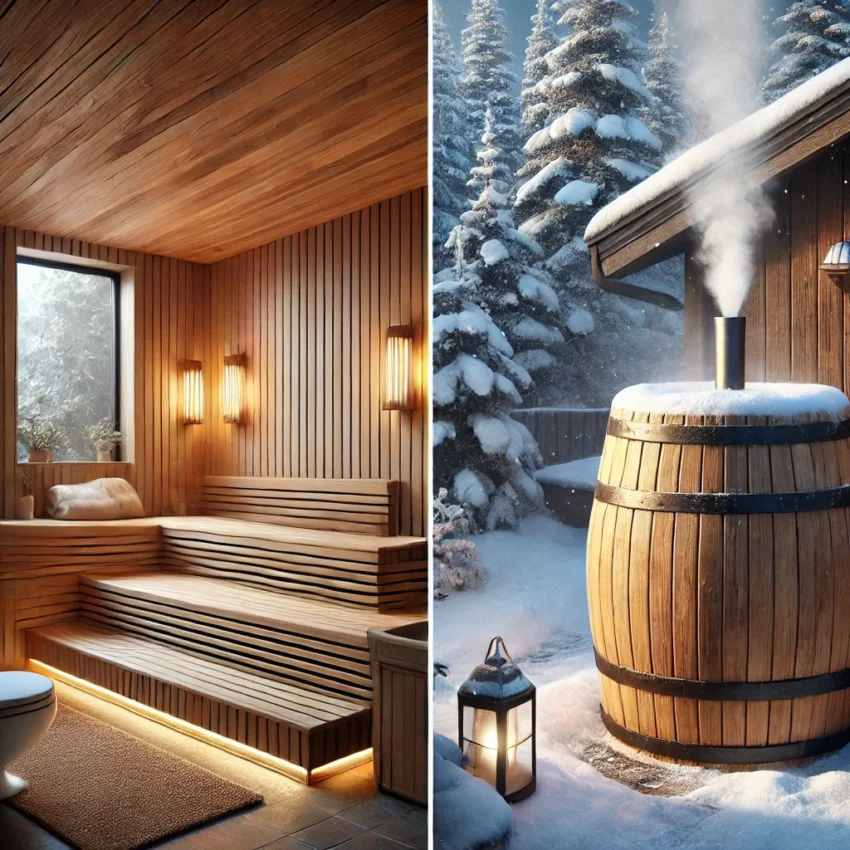Choosing between an outdoor sauna and an indoor sauna involves more than where you place it. The structure, maintenance, installation logistics, experience, and long-term use all vary significantly depending on the location.
Both indoor and outdoor saunas offer profound health benefits—improved circulation, detoxification, stress reduction, and recovery—but the right choice depends on your space, lifestyle, and goals.
This guide breaks down the pros, cons, and use cases of outdoor vs. indoor saunas, helping you make the most informed investment.
1. Installation Requirements
Indoor Saunas
- Require proper room dimensions, often a spare bathroom, basement, or gym area
- Must integrate with existing HVAC and moisture control systems
- Installation often involves floor reinforcement, vapor barriers, and dedicated circuits
Advantages:
- Controlled climate and indoor protection
- Easier to access year-round
- No need for weatherproofing
Limitations:
- Must fit inside existing structure
- May involve permits, electrical upgrades, and floor reinforcement
Outdoor Saunas
- Require a level, waterproof base such as concrete or decking
- Must be built with weather-resistant materials and roofing
- May involve plumbing (outdoor showers) or electrical trenching
Advantages:
- No space limitations from indoor layout
- Enables hot/cold contrast therapy in nature
- Visually separates relaxation space from daily life
Limitations:
- Exposed to weather, UV, pests
- Requires additional planning for utilities and insulation
- May be restricted by HOA or local zoning
2. Experience & Ambience
Indoor Sauna Experience:
- Controlled, private, spa-like atmosphere
- Easily incorporated into daily routines (pre/post shower, workout)
- Limited connection to outdoor surroundings
Outdoor Sauna Experience:
- Immersive, nature-based, restorative environment
- Enhances contrast therapy with cold plunges, snow, or fresh air
- Often used as a ritual or destination space, separate from the home
Bottom Line: Indoor saunas are functional and consistent. Outdoor saunas are experiential and transportive.
3. Design Flexibility
| Feature | Indoor Sauna | Outdoor Sauna |
|---|---|---|
| Size limitations | Constrained by room dimensions | Flexible, can build larger units |
| Shape/architecture | Boxy, compact, built-in | Barrel, cabin, or modern cube style |
| Customization | May be limited by room shape | More freedom with layout and design |
| Ventilation needs | Tied to house ventilation | Independent airflow design |
4. Cost Breakdown
Indoor Sauna Costs:
- Lower shell cost if using existing walls
- May require upgrades to ventilation, electrical, and flooring
- Ideal for compact, cost-conscious builds
Outdoor Sauna Costs:
- Higher upfront cost for weatherproofing, roofing, foundation
- Increased labor or prefab kit assembly time
- May save on HVAC-related indoor remodeling
| Cost Factor | Indoor Sauna | Outdoor Sauna |
|---|---|---|
| Basic 1-person unit | $2,500–$4,000 | $3,500–$5,500 |
| Mid-size custom build | $5,000–$8,000 | $6,000–$10,000+ |
| Installation extras | Vent, drain, GFCI | Decking, trenching |
| Maintenance | Minimal indoors | Annual exterior care |
5. Maintenance & Longevity
Indoor Saunas:
- Protected from elements
- Lower risk of wood expansion or water infiltration
- Requires regular drying and cleaning to prevent mold
Outdoor Saunas:
- Exposed to rain, snow, UV, and temperature fluctuations
- Must be built with sealed, rot-resistant wood (e.g., Cedar, Thermo-Aspen)
- Needs regular re-sealing, roof checks, and drainage maintenance
Well-maintained outdoor saunas can last 20–30 years. Indoor units may last even longer due to controlled environments.
6. Privacy and Usage
- Indoor Saunas: More convenient and private, easier to use in early mornings or before bed
- Outdoor Saunas: May require robing up, walking outside—better for weekend rituals or group use
Consider:
- Will you use it solo or with guests?
- Do you prefer a routine habit or an immersive getaway?
Which Sauna Is Right for You?
| Choose Indoor Sauna If You… |
|---|
| Live in a condo or apartment with no yard access |
| Want year-round use without going outdoors |
| Prefer integrating sauna sessions into daily life |
| Have limited budget or want minimal maintenance |
| Choose Outdoor Sauna If You… |
|---|
| Have outdoor space and want a nature-based ritual |
| Value sauna as a separate, immersive retreat |
| Enjoy cold exposure therapy or seasonal contrast |
| Don’t mind regular maintenance and a higher install cost |
Conclusion: Function or Escape?
Both indoor and outdoor saunas deliver substantial wellness benefits, but the right choice depends on your living setup, personal preferences, and desired experience.
- For convenience and daily integration, go indoor.
- For ritual, escape, and nature immersion, go outdoor.
With proper planning and design, either option can become a powerful pillar in your health and wellness routine.
